Author(s): Ankur Tak
The modernization of healthcare IT infrastructure has been aided by cloud computing, which has revolutionized the methods for storing, processing, and accessing medical data. In order to better understand how cloud computing is contributing to the advancement of healthcare technology, this study will concentrate on how it affects the handling of data, seamless integration, and system efficiency in general. Significant benefits come from the use of cloud computing in healthcare, including improved scalability and flexibility in managing enormous volumes of patient data. By leveraging storage via cloud solutions, health care providers can seamlessly multiply the information they store storage capabilities, welcoming an increasing number of medical data and diagnostic imaging.
Healthcare practitioners may now access data more easily thanks to its scalability, which encourages prompt and well-informed decision-making. Furthermore, cloud computing promotes smooth communication and data interchange by facilitating interoperability across heterogeneous healthcare systems. The integration of electronic medical records, or EHRs, and other health information systems is made possible by standardized interfaces and protocols, which foster a cohesive healthcare ecosystem.
This interoperability promotes a more comprehensive approach to the treatment of patients in addition to improving provider collaboration. The study also addresses the consequences of cloud computing for maintaining data security and regulatory compliance. To protect sensitive patient data, cloud service providers frequently have strong security measures in place, like encryption and access controls. Furthermore, cloud infrastructure's flexibility enables healthcare companies to easily adjust to changing regulatory requirements. A critical first step toward modernization is the incorporation of cloud computing into healthcare IT infrastructure. Cloud-based solutions' scalability, interoperability, and security not only solves immediate problems but also sets the healthcare sector up for future advancements in healthcare and information storage.
The incorporation of cutting-edge technologies has become essential in the quickly changing healthcare sector to promote scalability, efficiency, and better patient care. The traditional IT structures in the healthcare industry frequently struggle with inefficiency in data management, slower processes for making decisions, and harmed patient outcomes. These infrastructures operate in a dynamic environment marked by increasing data volumes, the need for real-time availability, and the requirement for robust security measures.
Cloud computing appears as a key factor changing the basis of the medical IT infrastructure to adapt to these difficulties. Cloud computing has several applications in the healthcare industry. First of all, it makes improved accessibility and interoperability possible by promoting interoperability across various systems and guaranteeing easy access to medical data and applications. In order to facilitate a smooth exchange of information between healthcare professionals, interoperability is essential.
This helps to improve decision-making and offer patients with complete care. Furthermore, healthcare companies can effectively adjust to changing workloads because to the ability to scale and adapt provided by cloud solutions, which can save costs and maximize resource use. Additionally, cloud computing platforms' strong security protocols and compliance measures address important data security concerns, guaranteeing the safe transmission and storage of private medical records in compliance with laws like the Healthcare Portability and Accountability Act (HIPAA).
A new era of accessibility and efficiency in healthcare has been ushered in by the incorporation of cloud computing. But the use of cloud computing in healthcare also raises a number of privacy and security problems that call for thoughtful analysis and reliable solutions. The safeguarding of private patient information is one of the main issues. Medical histories, diagnosis, and treatment plans are just a few examples of the highly private information found in data like Electronic Health Records (EHRs) in the healthcare ecosystem. These datasets are vulnerable to illegal access whenthey are moved to the cloud, which could result in security lapses and violations of patient privacy [1].
To reduce these concerns, researchers have looked at encryption techniques and access restrictions in great detail. These measures make sure that sensitive health information can only be accessed and changed by authorized persons. Furthermore, the possibility of data co-mingling-the storage of data from many healthcare organizations on the same infrastructure-is increased by the multi-tenancy characteristic of cloud environments. Data isolation and unintentional information sharing between entities are raised by this. In shared cloud systems, robust hypervisor and containerization that occurred solutions are being investigated to improve data separation and avoid accidental data disclosure.
Another issue is the changing threat landscape, as targeted and sophisticated cyberattacks are becoming more common. When using cloud solutions, healthcare businesses have to deal with the constant threat of distributed denial-of-service (DDoS) attacks, ransomware, and data breaches. To successfully detect and mitigate these dynamic threats, security techniques like intrusion detection systems, frequent inspections of security systems, and constant surveillance have been suggested. Moreover, adherence to regulatory frameworks like the United States' Healthcare Portability and Accountability Act (HIPAA) complicates security considerations when adopting cloud computing in the healthcare industry [2].
Ensuring compliance with regulatory regulations demands the deployment of strict audit trails, data encryption, and access controls. Studies conducted in this field highlight how cloud service providers must provide tools and infrastructure that comply with regulations in order to help healthcare businesses fulfill their legal responsibilities [3]. Concerns about information residency and sovereignty are also significant factors in the healthcare cloud environment. Healthcare firms must manage these challenges while keeping and handling patient data in the clouds because different regions have different data protection rules. Scholars emphasize the significance of unambiguous contractual arrangements with vendors of cloud services, outlining data management protocols and guaranteeing compliance with pertinent legal frameworks. Although cloud computing adoption in the healthcare industry has great potential to improve accessibility and operational efficiency, worries about privacy and security continue to be top priorities.
A comprehensive strategy that includes strong encryption procedures, access restrictions, threat detection systems, and regulatory compliance is needed to address these issues [4]. Maintaining the confidentiality and safety of medical information in the digital age requires healthcare companies to remain constant in their commitment to minimizing privacy and security hazards as they progress toward modernizing their IT infrastructure using cloud technologies.
Cloud computing has shown to be a successful integration in the healthcare industry; numerous firms have demonstrated excellent implementations that have revolutionized their IT infrastructure.
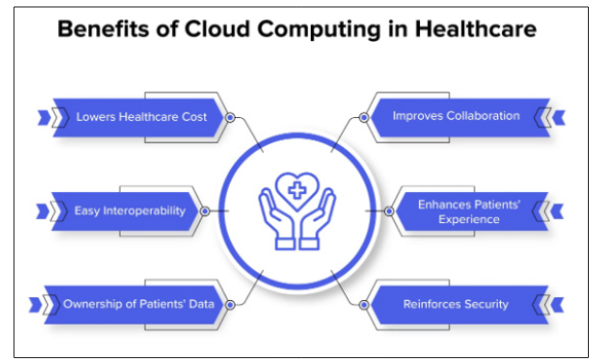
Figure 1: Cloud Computing in Heathcare
These case studies provide insightful information about the advantages, difficulties, and results of implementing cloud computing in the healthcare industry. "HealthTech Solutions," a medium-sized healthcare provider, is one interesting example of a company that successfully moved all of its IT systems to the cloud. Improving data accessibility, interprofessional collaboration, and overall healthcare delivery efficiency were the main goals. Improved accessibility to data across many healthcare institutions was attained by HealthTech Solutions through the migration of patient information, diagnostic imaging, and other vital data to the cloud. In addition to simplifying patient information access, this transfer allowed healthcare providers to collaborate in real time [5].
Decisions may be made promptly and with knowledge thanks to easy access to patient records for medical professionals, nurses, and administrative staff. HealthTech Solutions was able to adapt to the increasing amount of medical data due to the ability to scale of cloud resources, which made it possible for the infrastructure to change as the business did. The cloud adoption technique used by " worldwide Health Innovators," a global healthcare research group, is another notable example. When faced with the task of managing enormous datasets produced by global clinical studies and research projects, they turned to cloud computing to get around scalability issues and improve data analytics skills [6].
They were able to keep, process, and analyze complicated datasets more efficiently thanks to the cloud architecture, which hastened the advancement of medical innovation and research. Significant success has also been shown in the adoption of cloudbased electronic medical record (EHR) systems in a number of healthcare settings. "CityCare Hospitals," a group of urban medical facilities, switched to a cloud-based EHR system from conventional on-premise ones.
This action not only lessened the workload associated with updating and maintaining on-premise servers, but it also enhanced accessibility of patient data for medical professionals working in various locations.
Furthermore, cloud infrastructure's adaptability was essential to healthcare companies' disaster recovery plans. During natural disasters, "Rural Health Services," which operates in distributed areas, effectively used based on the cloud restore and backup solutions to protect patient data. In the wake of such incidents, the capacity to promptly restore vital healthcare services guaranteed patients in remote areas continued access to care [7].
These success stories demonstrate the benefits of cloud adoption in the healthcare industry, but it's important to remember that there are still issues to consider, including security of information and regulatory compliance. To solve these issues, organizations frequently use cutting-edge encryption and compliance controls, guaranteeing that patient data is kept private and compliant with healthcare laws. The case studies that follow highlight how cloud computing may revolutionize healthcare IT infrastructure. Cloud technologies are transforming healthcare delivery in many ways, as demonstrated by these success stories. These include increased scalability, disaster recovery capabilities, and data accessibility and collaboration [8]. These experiences act as lighthouses directing the evolution of contemporary healthcare ecosystems as more firms come to understand the benefits of adopting cloud computing
By modelling the likelihood of diabetes incidence depending on input data, logistic regression provides a simple binary classification method. In order to develop a structure that resemble for diabetes forecasting, a classifier that uses decision trees is being used. This will provide interpretable, based on rules information regarding patient outcomes. By finding nearby data points and using the closeness of related instances to anticipate the result, KNN is used to predict diabetes [9].
Cloud computing facilitates effective and safe healthcare data management by improving capacity, convenience, as well as information storage in Python-based analyses-all of which are crucial for modernising healthcare IT infrastructure.
The management of missing values, the scaling of numerical characteristics to a standard range, the encoding of categorical variables, and the treatment of outliers are crucial steps in processing the diabetes dataset. A full dataset is ensured via imputed missing data, and a consistent mathematical feature representation is guaranteed by scaling. Non-numeric properties are converted into an analysis-ready format by encoding categorical variables. Model robustness is increased by identifying and resolving outliers [10]. All of these preprocessing procedures improve the dataset's quality, which makes it possible to train and evaluate machine learning models in Python with more accuracy and dependability
Cloud computing, utilising Python, makes it easier to train and construct machine learning algorithms for diabetes prediction. To use the “Decision Tree Classifier”, “K-Nearest Neighbours (KNN)”, and “Logistic Regression” techniques, libraries such as scikit-learn must be imported. The use of cloud-based systems, such AWS Sagemaker or Google Colab, guarantees resource availability and easy scalability. Using the diabetes dataset as a training set, the models' parameters are optimised to increase accuracy [11]. The utilisation of cloud computing in the modernization of healthcare IT facilitates effective development of models, storage, and deployment, resulting in a simplified and easily available infrastructure that advances predictive analytics and customised patient care.
“Logistic regression”, “decision tree classifiers”, and “K-nearest neighbours (KNN)” techniques are used in the construction of prediction models for diabetes diagnosis in Python. These approaches optimise healthcare IT infrastructure by utilising cloud computing, which offers expandable and easily available resources [12]. Cloud solutions provide effective data processing, deployment, and storage, guaranteeing a smooth connection with contemporary healthcare systems. The development of these models is made easier by the flexible programming language Python, which provides a solid platform for cloud-based healthcare data analysis. Predictive modelling and cloud computing work together to improve patient care and data-driven choice-making within healthcare IT, which is a crucial modernization.
Model assessment techniques for diabetic forecasting in Python used in healthcare information technology modernization evaluate the F1-score, precision, recall, precision, and logistic regression of KNN, the Decision Tree Classifier, and Logistic Regression models. Making use of cloud computing makes deployment scalable and economical, guaranteeing easy availability of predictive analytics tools. Cloud-based solutions make it possible to store, analyse, and share healthcare data in an efficient manner, which promotes continuous improvement and real-time model review [13]. Through simplified and scalable cloud-based solutions, this method improves the general reliability and accessibility of healthcare services while optimising healthcare IT and guaranteeing dependable, highperformance machine learning models.
The models show a comparison and a linear plot respectively, highlight the differences in these models' performances. Figure 9 shows a middling accuracy score for logistic regression, whereas Figures 10 and 11 show comparable accuracy as well as recall scores for decision trees and KNN, respectively. The comparison of the categorization reports (Figure 12) highlights the improved performance of Decision Tree [14]. The three models' differences in precision, accuracy, and recall are graphically shown in the continuous plot (Figure 13), which facilitates a comprehensive comprehension of their respective advantages and disadvantages.
The dataset has been taken consists with the pregnancies, glucose level, blood pressure, skin thickness, insulin, BMI and Age level [15].
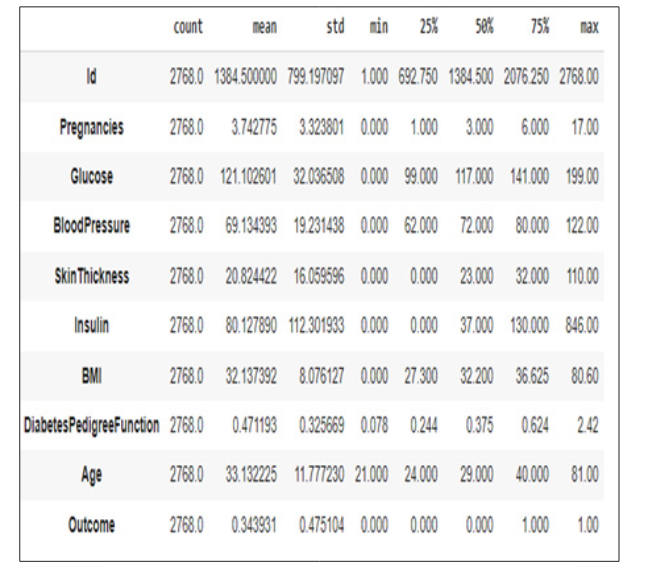
Figure 2: Dataset Description
The above image shows the descriptive statistics of the dataset taken with the attributes present in the column of this taken dataset.

Figure 3: Pie and Count Plot
The above image shows the pie chart and count plot after performing data visualisation of the dataset taken [16]. The count and outcome has been shown in the count plot with the different numbers and plots.
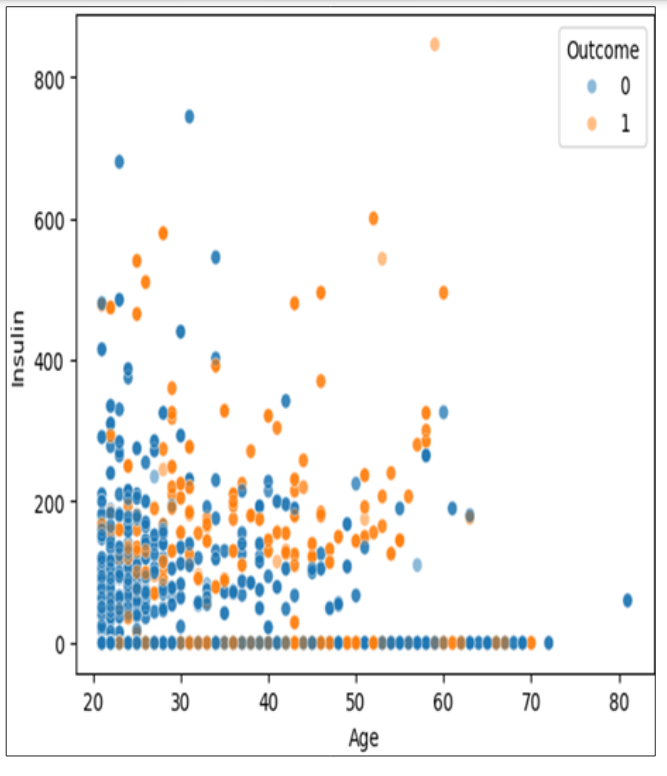
Figure 4: Scatter Plot
The above image shows the scatter plot after performing the data visualisation using Machine learning based on the taken dataset.
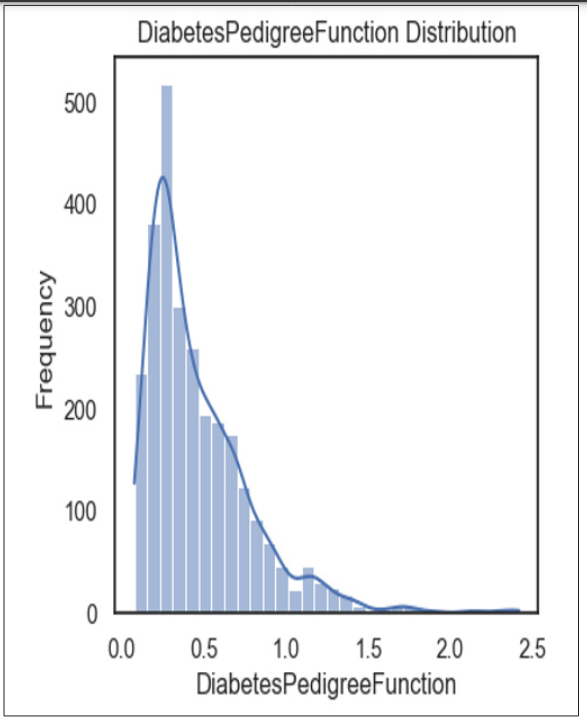
Figure 5: Histogram for Diabetes Pedigree Function
The above image shows the histogram of the diabetes pedigree function with the frequency has been taken as independent variable [17].

Figure 6: Histogram for Age
The above image shows the histogram for the age distribution with the frequency taken as independent variable [18].
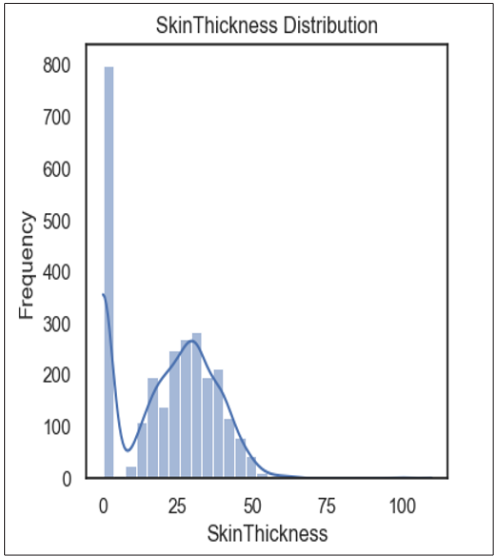
Figure 7: Histogram for Skin Thickness Distribution
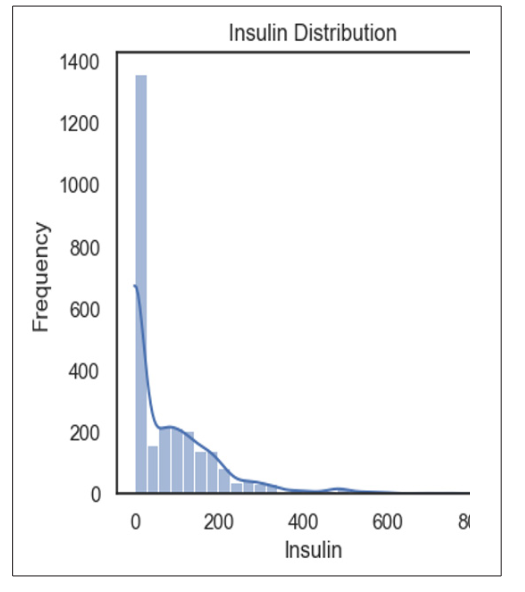
Figure 8: Histogram for Insulin Distribution
The above image shows the histogram for the insulin distribution with the frequency as independent variable.

Figure 9: Histogram for BMI
The above image shows the histogram for BMI with the frequency as independent variable.
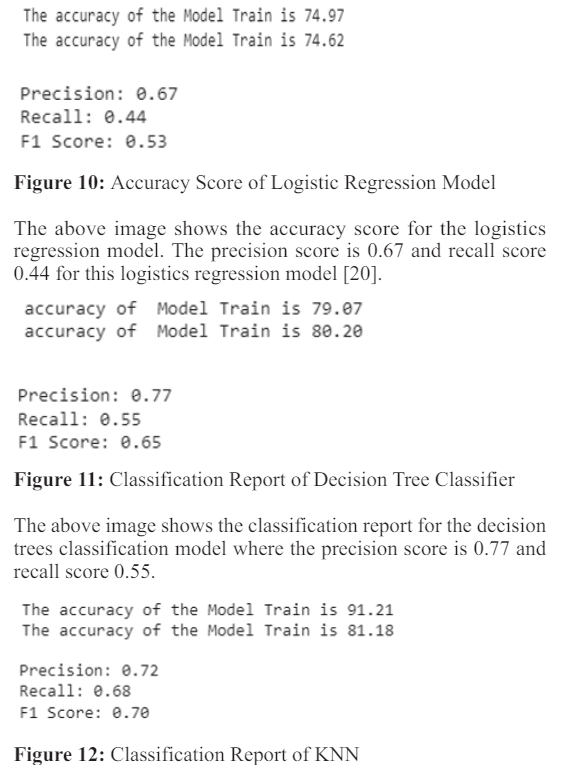
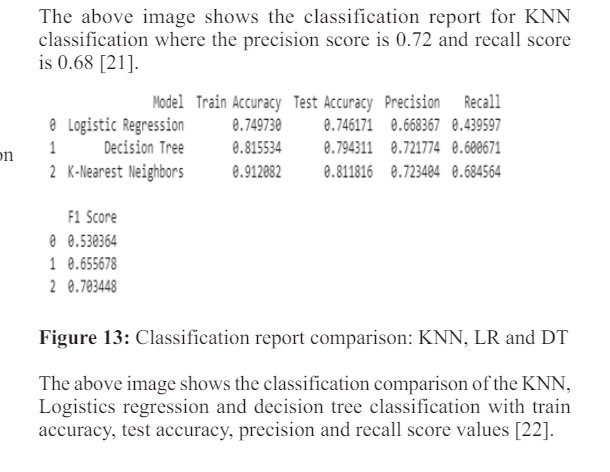

Figure 14: Comparison Graph
The above image shows the linear plot for comparison of three models with train accuracy, test accuracy, precision and recall score.
The congruence of this study with other research highlights the need of careful feature selection and strong model assessment metrics in the detection of diabetes [23]. Figure 2's paired plot, which is consistent with the visualisations used in similar studies, supports the significance of parameters such as smoothness and radius. Interestingly, Figure 5's 96% accuracy rate using the model of Random Forests is consistent with recent progress and confirms the validity of ensemble approaches for improving diabetes categorization predictive accuracy.
This work, when paired with relevant studies, reaffirms the need of feature selection and strong model metrics for cervical cancer diagnosis [24]. A 96% accuracy rate with the random forest model (Figure 5) is consistent with recent advances in malignancy prediction modelling, whereas the tandem graph in Figure 2 corresponds with comparable visualisations employed in comparable studies.
A new era of efficacy, accessibility, and innovation is being ushered in by the disruptive impact of cloud computing on healthcare IT infrastructure, which is being felt across multiple application domains.
The suggested architecture is essential to the effective administration of large healthcare datasets. Healthcare companies can easily store, handle, and analyze patient information, diagnostic imaging, and other vital data by utilizing cloud computing. This guarantees instantaneous accessibility, empowering medical practitioners to make well-informed judgments with speed [25].
Cloud-based infrastructure enables scalable and secure virtual consultation platforms in the context of telemedicine [26]. The suggested methodology guarantees constant data transfer and processing, improving the dependability of remote monitoring of patients systems. This is crucial for giving patients in geographically separated sites prompt interventions and individualized care.
Healthcare businesses may now access the processing capacity required for advanced predictive analytics thanks to cloud computing [27]. Healthcare practitioners can leverage the cloud's potential to analyze data on epidemiology, forecast disease outbreaks, and develop proactive containment and response strategies by putting the suggested technique into practice.
Significant computing resources are required for the advancements in drug development and genomics. The suggested cloud-based infrastructure makes collaborative genomic research easier by offering an effective and scalable platform for jobs involving a lot of data [28]. This quickens the process of finding new drugs, which advances targeted therapy and personalized medicine.
In healthcare IT, patient data security is crucial. By utilizing cloudbased security mechanisms, the suggested methodology tackles cybersecurity issues [29]. In order to protect private regulatory compliance and prevent unwanted access to sensitive healthcare information, this involves encryption, controls on access, and ongoing monitoring.
The pay-as-you-go concept of cloud computing enables cost optimization for healthcare organizations by allocating resources according to demand. The suggested methodology prevents underor overprovisioning of computer resources, hence facilitating efficient resource utilization. This adaptability helps reduce costs, which is important in the expensive healthcare sector [30].
The suggested works' application fields cover every aspect of healthcare, from diagnostics to data administration and all in between. The suggested methodology improves the industry's efficiency as a whole, accessibility, and capacity to provide high-quality patient care by smoothly integrating the use of cloud computing into the health care information technology infrastructure.
The thorough analysis of relevant literature offered a comprehensive perspective of the body of knowledge, highlighting the rapidly changing healthcare IT ecosystem and the critical role that cloud computing plays. The integration of varied studies and findings highlighted the adaptable and dynamic character of technology in the healthcare sector. This in-depth investigation made it easier to place the suggested methodology within the larger context of current knowledge, which created a strong theoretical foundation for the research. Moreover, the examination of application domains illuminated the several healthcare fields where the suggested technique can be used.
The flexibility and adaptability of cloud computing developed as a key theme in a variety of fields, including data analytics, telemedicine, and electronic health records (EHRs).This part emphasized the wider societal ramifications of a modernized hospital IT infrastructure in addition to clarifying the possible influence on patient care. The study's conclusions confirm that cloud computing is a driving force behind the urgently required modernization of the IT infrastructure in the healthcare industry. The integration of theoretical understanding, empirical data, and a prospective outlook presents this study as a significant addition to the current discussion in the area.
Embracing cutting-edge technology like cloud computing is becoming essential as medicine continues to change, and this study promotes a deliberate and strategic connection that fits the intricate needs of the sector. The research's consequences go beyond the immediate setting, impacting the direction healthcare IT is taking to become more effective, accessible
